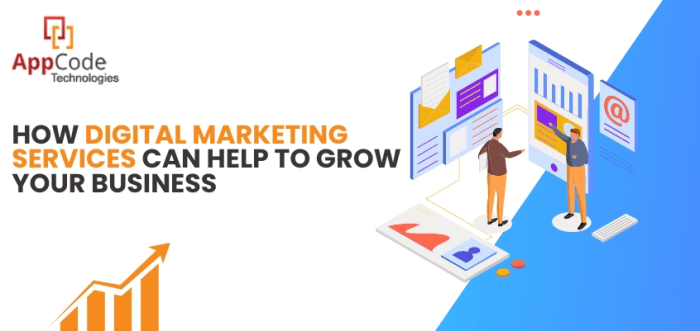How to market services digitally is a crucial topic for businesses aiming to thrive in today’s competitive landscape. Digital marketing transcends traditional methods, offering service-based industries innovative ways to connect with their target audiences. From exceptional online presence to tailored content strategies, the digital realm is rich with opportunities for service providers to engage and convert potential customers.
Understanding the nuances of digital marketing for services involves recognizing the diverse approaches utilized by various industries. A strong online footprint is more than just a necessity; it is a strategic advantage that can elevate a service provider’s visibility and credibility in a crowded marketplace.
Understanding Digital Marketing for Services
Digital marketing has become an indispensable part of promoting service-based businesses. Unlike product marketing, digital marketing for services emphasizes the intangible value that services provide. This includes building trust, establishing authority, and creating long-term relationships with clients. Various industries, such as healthcare, education, and hospitality, utilize digital marketing effectively to reach their audiences.
For instance, healthcare providers use content marketing to share valuable health tips and articles that demonstrate expertise, while educational institutions leverage social media to engage prospective students through virtual tours and webinars. A robust online presence is crucial for service providers, as it enhances visibility, facilitates customer engagement, and ultimately drives conversions.
Identifying Target Audiences

Defining and segmenting target audiences is essential for effective service marketing. The first step involves conducting market research to identify potential customer demographics, preferences, and behaviors. Utilizing tools such as surveys, social media analytics, and website analytics can yield valuable data on audience characteristics.
To create an ideal customer profile, consider factors such as age, gender, income level, and interests. For example, a personal training service might target health-conscious individuals aged 25-40 with disposable income who engage with fitness content online.
Content Marketing Strategies
Content marketing plays a vital role in engaging customers and showcasing services. Effective content types for service-oriented businesses include blog posts, case studies, videos, and infographics. These formats can highlight the benefits and value of services offered.
Organizing a content calendar ensures a consistent flow of promotional material. It can include themes for each month, such as customer testimonials, how-to guides, and seasonal promotions. Engaging blog posts should focus on addressing customer pain points and providing solutions, ensuring that the content is informative and relevant.
Social Media Marketing Approaches
Selecting the best social media platforms for marketing services is crucial. Platforms like Facebook, Instagram, and LinkedIn offer unique advantages for different service industries. For instance, Instagram is ideal for visually-driven services like photography or interior design, while LinkedIn is more suited for B2B services.
Creating engaging posts involves using high-quality visuals, crafting compelling captions, and utilizing relevant hashtags. Common pitfalls include neglecting interaction with followers and posting inconsistent content. Avoiding these mistakes ensures effective engagement and brand loyalty.
Email Marketing Techniques
Building an email list specifically for service marketing requires strategic planning. Offering incentives such as exclusive discounts or free consultations can encourage sign-ups. Additionally, segmenting the email list based on customer preferences enhances targeting accuracy.
Compelling email campaigns should include clear calls-to-action and visually appealing layouts. Personalization is key; addressing recipients by name and tailoring content to their interests can significantly increase conversion rates.
Search Engine Marketing for Services, How to market services digitally

Paid advertising plays a critical role in the digital promotion of services. Effective ad campaigns might include search engine ads targeting specific s related to the service. For example, a plumbing service could run ads for “emergency plumbing” to capture urgent inquiries.
Best practices for optimizing ads include using relevant s, writing persuasive ad copy, and ensuring a seamless landing page experience. Monitoring ad performance and adjusting strategies based on analytics can lead to improved results and return on investment.
Website Optimization for Service Marketing

An effective service-oriented website must include essential elements such as clear service descriptions, customer testimonials, and contact information. A user-friendly design enhances navigation, while incorporating call-to-action buttons can encourage visitor engagement.
Mobile optimization is vital, as many users browse services via smartphones. Ensuring fast loading times and responsive design can significantly improve user experience. A checklist for website improvement should focus on visual appeal, mobile compatibility, and easy access to service information.
Analyzing Marketing Performance
Tracking and measuring the effectiveness of digital marketing campaigns involves utilizing analytics tools to assess various metrics. Key performance indicators for service businesses may include website traffic, conversion rates, and customer acquisition costs.
Creating a report template can help assess marketing performance by detailing campaign objectives, results, and areas for improvement. Regular analysis allows businesses to fine-tune their strategies and maximize return on investment.
Building Customer Relationships Online
Maintaining customer engagement after a sale is crucial for fostering long-term relationships. Consistent communication through newsletters, follow-ups, and social media interaction ensures that customers feel valued.
Encouraging customer feedback and online reviews can enhance credibility and trust. Actively responding to reviews, both positive and negative, demonstrates commitment to customer satisfaction and helps in building brand loyalty.
Future Trends in Digital Marketing for Services
Emerging trends in digital marketing, such as the integration of artificial intelligence, are set to impact service industries significantly. AI can streamline customer service through chatbots, personalize marketing efforts, and analyze consumer behavior data.
Predictions for the future landscape of digital marketing suggest an increased emphasis on data-driven strategies and automation, as businesses seek to enhance efficiency and customer engagement. Adapting to these trends will be essential for service providers aiming to maintain a competitive edge in the evolving market.
Closure: How To Market Services Digitally
In summary, mastering How to market services digitally equips businesses with the tools they need to build lasting customer relationships and adapt to evolving market trends. By leveraging effective strategies across platforms—from content marketing to social media engagement—service providers can significantly enhance their outreach and conversion rates. As we move forward, staying ahead of digital marketing trends will be essential for sustained success and growth in service industries.